Ontario Fish and Wildlife News
Category: article
Oct 5th, 2021 by Keith Worrall
Modified Oct 5th, 2021 at 12:52 PM
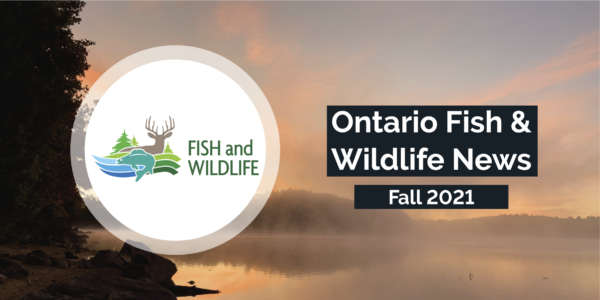
Anglers, hunters and trappers,
Thank you for your continued support of the Ministry of Northern Development, Mines, Natural Resources and Forestry’s (NDMNRF) Ontario Fish and Wildlife News, your peek at how your licence dollars support Ontario’s fish and wildlife management. You are receiving this newsletter because you are a current or recent Outdoors Card holder.
New year, new rules for baitfish and leeches

Ontario is rolling out new rules related to the use and movement of baitfish and leeches when fishing in the province. This is all part of the province’s plan to prevent the spread of invasive species as well as diseases like viral hemorrhagic septicemia (VHS) that can devastate Ontario’s fish stocks.
Starting on January 1st, 2022, Ontario will be divided into four Bait Management Zones (BMZs) —Northwest, Northeast, Central and Southern. Anglers, if you live in the zone where you are fishing, you will be permitted to harvest and use baitfish and leeches in that zone. If you are fishing outside the zone in which you reside, then you will need to purchase and use baitfish and leeches from the BMZ where you are fishing.
Baitfish and leeches can only be moved within the BMZ where they were harvested or purchased, with some exceptions, including moving baitfish and leeches into an adjacent Great Lake or a portion of the Ottawa River.
Anglers fishing in their home BMZ should be prepared to show government issued identification to demonstrate their place of residence. Anglers using live bait outside of their home BMZ must purchase their baitfish and leeches and can keep them for up to two weeks. They must also keep a legible receipt after you have purchased them to show to a conservation officer.
These changes come after years of research, data collection and consultation with anglers in the province. Anglers are also reminded to:
- Safely dispose contents of your bait container at least 30 metres from any lake, pond, river or stream
- Dispose of fish waste, heads and tails in the garbage, not waterways, when cleaning fish
- Put unwanted roe or baitfish in the garbage
- Empty livewells and bilges away from water, where the water will be absorbed into the ground
- Inspect and disinfect your gear, if necessary
Check ontario.ca/baitfish for updates on BMZs.
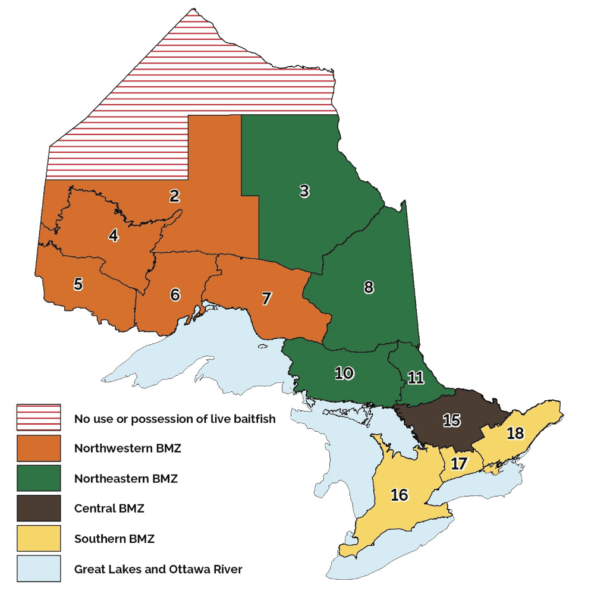
BMZ Map

The ministry now has two options to take Ontario’s Hunter Education Course, making the course even more accessible for aspiring hunters.
On July 26, 2021, the province launched its online hunter education course. The fully online course provides students with the flexibility of completing the course from their home and on their own schedule. In-person courses will continue to be available through our network of knowledgeable, experienced instructors. For your convenience, these courses are often combined with the Canadian Firearms Safety Course which is required to hunt with a gun.
Just like the in-person course, the online option introduces students to information about:
- hunting safety and equipment
- hunting laws and regulations
- hunter responsibilities
- wildlife management
- hunting techniques
- wildlife identification
Whether a student takes the online or in-person hunter education course, they will learn and be tested on the same information. Encouraging safe and responsible hunting continues to be a key focus.
If you or someone you know is interested in taking the Ontario Hunter Education Course, please visit www.ohep.net for more information.

This year’s moose seasons are open in some Wildlife Management Units (WMUs)! Here are a few things to remember before moose hunting this fall.
Don’t forget to claim your tag!
If you were awarded a tag in the second chance allocation, you must claim your tag prior to your hunt. You cannot hunt on a tag you have been awarded unless it’s claimed, printed and you are carrying it with you. A moose licence must be purchased to claim your tag.
You can claim your tag and purchase your moose licence:
online at huntandfishontario.com
learn how to claim your moose tag online
in person at a licence issuer or participating ServiceOntario location
Please note that the automated phone line is not available to claim your tag in the second chance allocation.
Have your moose tag and licence ready to go
Claimed tags from the primary and second chance allocation are now available for printing. We recommend that hunters print their tags close to their hunt date to prevent tags from getting lost or damaged. A reminder, your tag must be printed and cannot be saved to your phone. You need to carry your Licence Summary showing your moose licence with you when hunting. Your Licence Summary can be printed or saved to your phone.
In your online account under the My Active Licences page, the “Printable Tag” column will include the following indicators:
“Yes” (tag is available to print)
“Printed” (tag was printed)
You may only print your tag once. Please ensure your printer is functioning properly and that double-sided printing is turned off. Printing tips are available online.
Didn’t get a tag in the allocation process?
Here’s how you can still hunt moose this fall. Purchase your moose licence and:
party hunt with a tag holder
obtain a tag by purchasing a hunting package from a tourist outfitter
party hunt with a tag holder who has purchased a hunt from a tourist outfitter
Purchase your moose licence online or in-person at a licence issuer or participating ServiceOntario location.
To party hunt with a tag holder you must:
carry your licence summary with you that shows your purchased moose licence, applying to the moose tag allocation process did not provide you with a licence. You can print your licence summary or save it to your mobile device.
All hunters who are hunting on a moose tag issued by a tourist outfitter must be the registered guests of the outfitter who issued the tag.
Learn more about hunting moose with a tourist outfitter.
Your moose points beyond 2021
Now that the 2021 moose tag allocation process is over, here’s a reminder of how your points will work beyond this season:
If you applied to one or both allocation stages, but didn’t claim a tag you were awarded based on points, you will retain your points and gain a point
If you claimed a tag you were awarded based on points (any tag from the primary allocation or from your first choice in the second chance allocation), your points will reset to zero
If you claimed a tag from either your second or third choices in the second chance allocation, you will retain your points and gain a point
If you selected WMU “99Z” as your first choice in either allocation stage, you will gain a point
Obtaining a tag as part of a hunting package from a tourist outfitter will not affect your points
You cannot gain more than one point per year
Changes to points will be reflected in hunters’ online accounts and through the automated phone system in early 2022. Learn more about your points beyond 2021.
Don’t forget, anyone who purchases a moose licence must complete a mandatory hunter report by the deadline.
We’re hiring!

In May 2021, the Ontario government announced that it is recruiting 25 new conservation officers. The recruitment process is currently underway and the Ministry of Northern Development, Mines, Natural Resources and Forestry’s Enforcement Branch is excited to add these new officers throughout the province.
Conservation officers are vital in protecting our vast natural resources and ensuring public safety by patrolling the lakes, rivers, trails, and backroads of Ontario. Through education, compliance and enforcement, their work helps to manage our resources so we can safely enjoy them for years to come.
Ontario currently employs 184 highly trained conservation officers in over 50 locations across the province. These officers include front-line field officers, canine handlers, and intelligence and investigations specialists who lead year-round enforcement service delivery.
Hiring and training more officers will strengthen enforcement efforts and help make sure our resources are sustainably managed. The new recruits will complement our existing conservation officers and benefit from working alongside highly trained and experienced staff.
Conservation officers currently enforce more than 27 different pieces of legislation to protect and regulate natural resources and help keep the public safe.
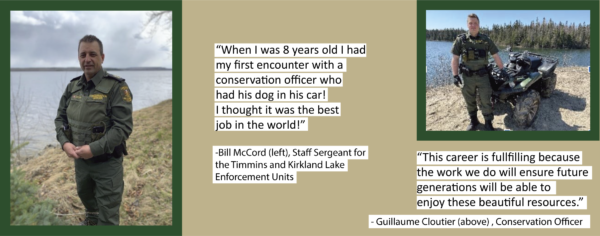

Wild pig sightings continue to be reported in scattered areas across Ontario.
Ministry staff have been closely monitoring invasive wild pigs throughout the province, and continue to monitor sightings, investigate cases, and where necessary, trap and remove wild pigs from the landscape.
The majority of the time, pigs that are found outside of a fence are owned pigs that have escaped from their enclosures. These could be domestic pigs, including pot-bellied pigs, and even Eurasian wild boar. Regardless, they are all considered a risk to the natural environment if left loose in the wild.
Visit our website to learn more about the types of wild pig sightings we have received over the last year in our latest Annual Report on Invasive Wild Pig Sightings: 2020-2021.
Please continue to report wild pig sightings to [email protected].

Mandatory hunter reporting is a valuable source of data used by the NDMNRF to support sustainable wildlife management.
Great news! Reporting rates have increased significantly since mandatory hunter reporting was implemented in 2019, and as a result the quality and quantity of data used to inform decision making is increasing. This means we can better manage the sustainability of Ontario’s wildlife populations and hunting opportunities.
Keep up the great work! Continue to complete and submit your mandatory hunter reports online or by calling 1-800-288-1155. It takes as little as 5 minutes to complete.
Any hunter who bought or was issued a tag to hunt elk, deer, bear, wild turkey or wolf/coyote (in Wildlife Management Units where a tag is required) and any hunter issued a licence to hunt moose is required to report. Hunters are required to complete a hunter report even if they did not hunt or harvest an animal.
For additional details on reporting deadlines and instructions on how to report, visit ontario.ca/hunterreporting.
Remember to hunt safe, submit your report and enjoy Ontario’s great outdoors!

Ministry researchers and partners studied the effects of human population and climate change on invasive species. They considered the potential for aquatic invasive species to arrive, survive and spread, developing models to predict which regions of Ontario are at greatest risk for new invasions now and in future. Researchers factored in whether habitat was suitable for species to move into new waterbodies, either through their own efforts or human activities.
Some key findings:
- With projected climate change, more habitat may become suitable for invasive species, especially in the north
- Prevention requires a mix of control methods, such as education and regulation
- Effects of some human activities (such as aquarium and water garden ownership) are concentrated near highly populated areas while others (boat-based fishing and recreational boating) help aquatic invasive species spread throughout the province
- Human activities connect otherwise isolated parts of the province
- Newly invaded waterbodies can be a source for invasion of other (nearby) waterbodies
These results will be used to help prevent the establishment and spread of aquatic invasive species to protect Ontario’s lakes.
You can help minimize invasive species spread by:
cleaning, draining, and drying equipment
properly using and disposing of live bait
learning to identify invasive species
Want more info? Request the report by emailing [email protected].
Meet the fish keeping our stocked species wild
What are broodstock?

A group of fish that are kept for breeding purposes and can include fish that have not yet reached sexual maturity as well as those that are mature.
Our broodstocks
Our hatchery broodstocks are a key element of our fish stocking program. These broodstocks, which are carefully selected and managed, supply most of the fertilized eggs used in our program. They support multiple fisheries objectives including restoring wild populations and increasing angling opportunities which allows you to keep on fishing!
We manage our broodstocks to retain their wild characteristics and natural genetic variation. This maintains their ‘wildness’, maximizing their chances of thriving following stocking. We also monitor and manage the health of these fish carefully to ensure that they are disease free.
Our numbers
The ministry’s Fish Culture Program maintains 18 genetically unique captive broodstocks, representing 7 different species, totaling approximately 370,000 fish or 41 metric tonnes, which is the equivalent to the weight of 8 adult elephants!
We rely on these broodstocks to produce over 13 million fertilized eggs or 53% of our requirements annually. This includes approximately 2.5 million fertilized eggs to support community and classroom hatchery partners across the province each year.
A lot of planning goes into these populations to ensure we always have a mature group of reproductive adults to meet our egg targets.
Retirement
Yes, our fish enter retirement. Our broodstocks are all different ages but typically range between 0-14 years old. When we retire broodstocks from service we often stock them into local waterbodies to provide you with amazing angling opportunities. This means that monster of a Brown Trout you caught last week could have once been in one of our culture facilities!
Find more information about Ontario’s fish stocking program here.
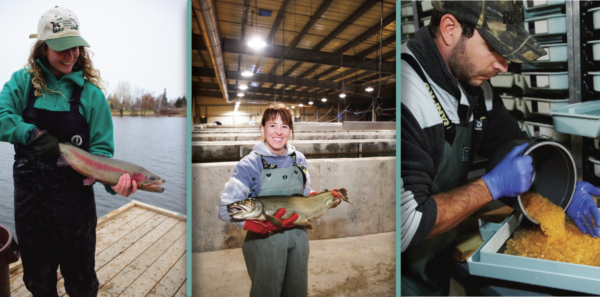

Summer may be over, but bear season is not!
For bears, this time of year can be the most important in helping them gain weight before they hibernate for the winter. Crops that are available now, like berries, acorns, beech nuts and mountain ash, help bears consume more calories and increase their fat reserves.
That’s why it’s important that you make sure that all ripe fruit is picked, and any fallen fruit is removed from your trees, so they are not rotting and creating a smell for bears to investigate. Bears have exceptional memories and will return again and again if they find an easy meal. Don’t forget to clean out your birdfeeders, composters and keep your garbage stored securely.
For more tips, visit ontario.ca/bearwise.

Chronic wasting disease (CWD) is a fatal, untreatable brain disease that affects members of the deer family (cervids), including white-tailed deer, elk and moose. It has not been found in wildlife in Ontario, but it has been found in 26 U.S. states, Alberta, Saskatchewan and Quebec. CWD is highly contagious. It can be spread by saliva, urine, feces, and blood or by exposure to a contaminated environment.
Ontario will be conducting its annual CWD surveillance program from October to December 2021 in two target regions:
Eastern Ontario, in Wildlife Management Unit (WMU) 65.
Southwestern Ontario, in WMUs 85C, 86B, 87A, 87B, 87C, 87D, 87E, 90B, 91A, 91B, 92A and 92D.
Hunter participation is key to the success of this program. With your help, we have tested over 13,600 hunter-harvested animals since 2002. All tests to date have been negative for CWD.
As of January 1, 2021, NDMNRF introduced additional measures to prevent CWD from entering Ontario. These include prohibiting import and movement of captive cervids and prohibiting the import of cervids harvested in other jurisdictions, with some exceptions. You can still import meat that has been deboned and packaged, antlers and skull cap with no tissue attached, tanned skins, and finished taxidermy mounts. Ontario has also prohibited the possession and use of natural lures or bait made from cervids; you could unknowingly be spreading CWD and infecting your local deer.
We are asking hunters to continue their vital support by submitting samples from any deer harvested in the 2021 target WMUs for testing. We will be offering 2021 collectable crests for the first 500 samples submitted in each zone.
To learn more about CWD and how you can help, visit ontario.ca/cwd.
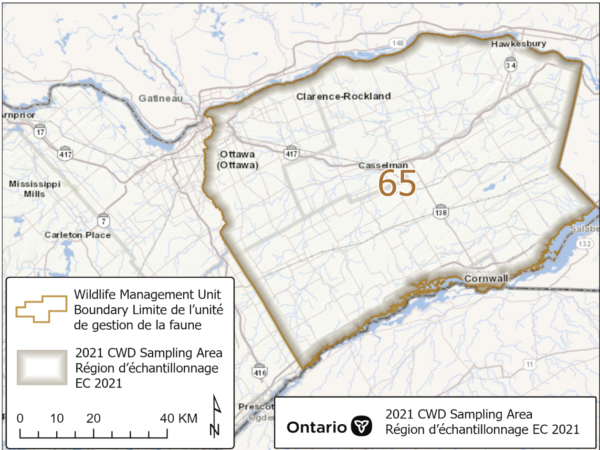

Calling all young artists: the 19th annual Kids’ Fish Art Contest is back!
The contest runs from October 4, 2021 to December 3, 2021. To enter, you must be a student who is a resident of Ontario, currently attending elementary or secondary school (or homeschooled) and be between the grades of 4-12.
Are you up to the challenge? Put your art skills to work and learn about fish in Ontario. This year’s species are brown trout and smallmouth bass.
Looking for some inspiration? Check out the winners from the 18th annual Kids’ Fish Art Contest!
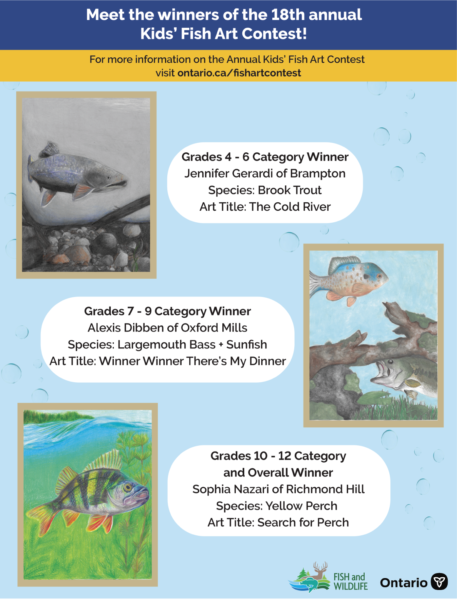
Kids Fish Art Winners
View the current Ontario Hunting Regulations Summary.
View the current Ontario Fishing Regulations Summary.
Visit our licensing website to:
purchase Ontario hunting and fishing licences, renew your Outdoors Card, apply to big game draws, check big game draw results and submit your hunter activity/harvest report
Visit Fish ON-line to plan your next fishing trip:
19,000+ waterbodies, customizable fish stocking lists, and 2,000+ fishing access points Fish and Wildlife Services Branch Ministry of Northern Development, Mines, Natural Resources and Forestry 300 Water Street
Peterborough, Ontario K9J 3C7.
To reach the Natural Resources Information and Support Centre
with your Outdoors Card and licence questions, please call:
1-800-387-7011 or 1-800-667-1940
(TTY) 1-866-686-6072
For general inquiries about NDMNRF programs and services
please use this email address: [email protected]